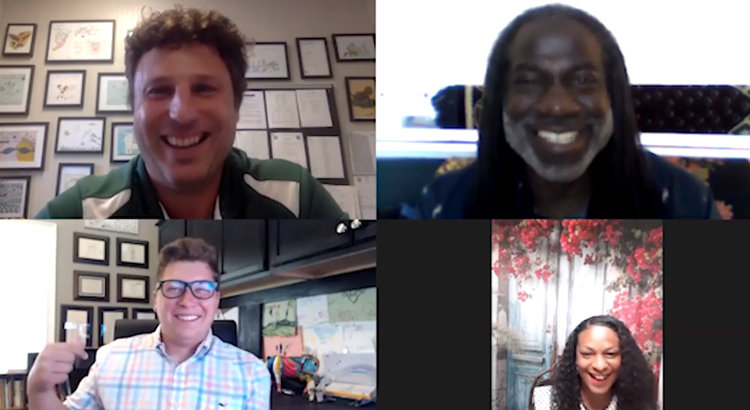
Offering some motivation during this time of social distancing can be challenging, especially for teachers who are contemplating how to make an uncertain new school year interesting and worthwhile for students, parents and themselves.
Although no one would wish for the situation we’re in, it has unleashed some incredible creativity.
Pren Woods, a middle school teacher in South Carolina and a finalist for the LifeChanger of the Year award, said he spent time while teaching remotely reaching out to students outside his regular classtime to keep them engaged in the things they treasure about school.
“We’ve got to think of ways to really bring everybody together because we are connected in so many ways,” he said at a recent TeacherTalk video webinar organized by LifeChanger. “What do kids appreciate about me and how can I keep that going to show them that social emotional learning is primary and the academics is secondary.”
And it’s not just the students whose social, emotional health needs attention, he said. “I know I was struck with when the pandemic hit all of a sudden I started missing the people I did car rider duty with – and I talked with them like five minutes a day – or the people I see at the same time at the microwave.”
Eric Crouch, an elementary school teacher in Georgia, said in the webinar that the human connection that’s created by chance encounters in a school hallway or during a conversation that’s unrelated to the curriculum is something that has been sorely missed during remote schooling.
“I always try to think of it like a bridge,” he said. “You can’t build a bridge and have it go somewhere if we don’t know where people need to go. Our job is to be the path, the support, to help people find their way across to where they want to be.”
And everyone who works in a school – teachers, administrators, office staff, bus drivers, janitors – are integral parts of that bridge who also need support during these trying times, he said. “And then you think of how much more stress and load we’ve added to that bridge,” he said. “It’s very concerning because we know a lot of our teachers are those support trusses that are holding the weight of that bridge.”
One of the solutions that Angela Brent-Harris, a kindergarten teacher in Florida, has used both in the classroom and in the remote situation, has been meditation techniques.
“For me mindfulness is key,” she said. “What I do is try to extend mindfulness, try to share with my colleagues, the students and parents, how to do guided meditation, to ease that pressure, release that stress, keep that communication open as well.”
She also made trips to some families’ homes to check in on them and make sure they’re doing well. “We need to keep a physical contact with each other through mindfulness, knowing that you have someone there with you, that telling them I believe in you so they know that they’re not alone in this and they know that we’re all in this together. A little bit of communication, staying in touch, practicing mindfulness is key to what we’re going through right now.”
It became clear for Peter Galasso, an elementary school principal in New Jersey, that missing the in-person contact was creating very real challenges.
“We started seeing the anxiety increases and the emotional disturbances,” he said. “We had to get connected. We needed the connection despite the virtual distance.”
So he worked with the team at his school to create activities that students got to share with one another virtually. And then his school offered the reward of donations to a charity in town for each submission. Students built a fort at home and then shared photos or videos.
“And all of a sudden the comments would blow up because there were kids begging to get on there,” he said. “Because they can’t see each other. So they’re looking at each other’s forts and giving feedback: ‘Wow, yours has lights.’ ‘Oh my gosh, yours has a door.’ It was wonderful.”
Other activities were developed, such as submitting a self-portrait. It became a competition to raise more money for charity, so students who at first did not participate began to get in on the act.
“It was all a lot of work,” he said. “But it was the most beneficial thing that we saw in terms of getting kids and parents because parents started watching the videos. It kind of dragged them along.”
It was successful enough that some version of it will be carried into the new school year, no matter how the year develops, as in-person, virtual, or some hybrid.
All of these teachers have been thinking long and hard about how to take the lessons they’ve already learned and refresh or modify them to ensure they’re creating the most rewarding experiences they can for their students, both for their academics, but also their social-emotional health.
Pren Woods said challenges lie ahead. But he wants to make sure innovations such as drive-through graduations that were developed out of necessity can be used in some form in the future.
“This doesn’t have to go away when we have a hybrid model,” he said, describing the excitement of decorating cars and parading through town at a distance instead of a traditional graduation. “I had a moment, I said, ‘This could be something that could be done multiple times a year.’ I want to challenge us all: What were those really neat, cool things that we did during the pandemic because we didn’t want kids and families to feel isolated that actually could now become a part of school culture as we move forward.”
Don’t miss the next TeacherTalks webinar. It’s on July 28th, and will focus on Creating Connections. Sign up here.
TC112689(0220)P

